Salt Dough Ornaments
These homemade salt dough ornaments are one of our favorite family crafts during Christmas! This recipe is so easy to follow, and you probably already have all the ingredients you need on hand.
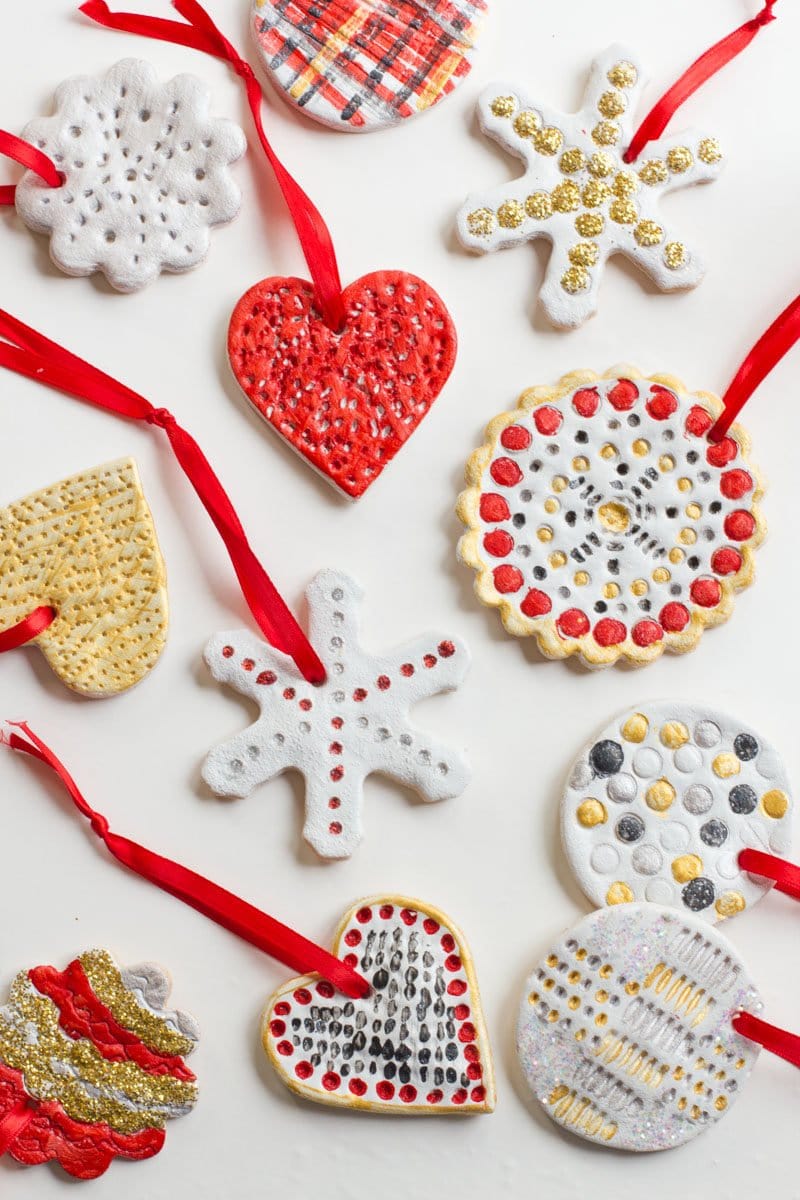
Why You'll Love This Salt Dough Recipe
This is the exact salt dough recipe my family has used for decades! So you can feel good that these ornaments will turn out great every time. Here's a few reason why this is the best recipe out there:
- No speciality ingredients or tools needed here! You probably have everything you need already in your pantry.
- This is such an easy and affordable holiday activity for the whole family. For just a few pennies, you can spend your afternoon connecting over a fun craft.
- Looking for budget-friendly handmade gift ideas? Salt dough ornaments are here to save the day!
- The dough is smooth and easy to work with. No sticky hands, messy counters (okay, maybe a little), or sensory overload.
- You can feel good that these ornaments will last. In fact, I still hang an ornament on my Christmas tree each year that I made as a kiddo in 1987 using this exact same recipe!
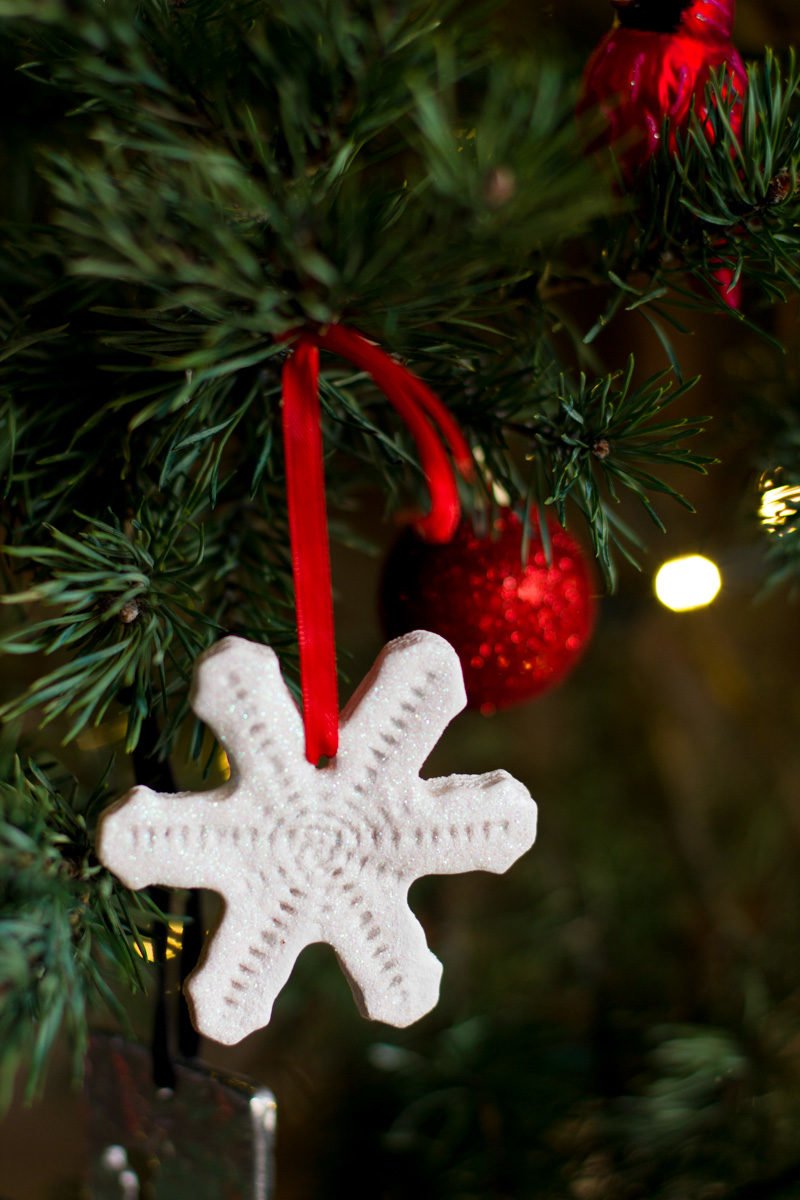
What You'll Need
Go ahead and open up your pantry, because I'm pretty sure you have everything you need to make basic ornaments on hand already. You'll need:
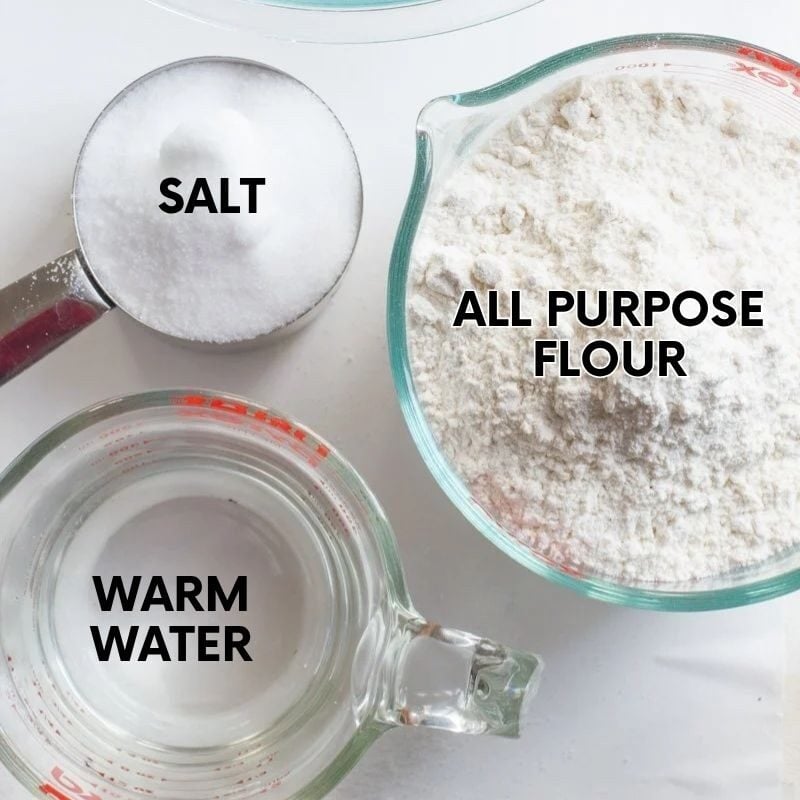
- All-purpose flour-I recommend sticking with all-purpose flour here because it's affordable, it's easy to work with, and it creates the most consistent color. Bleached all-purpose flour is best, but unbleached works, too. Since you aren't ingesting this at all, go ahead and get the bargain basement generic brand flour to save yourself some cash. Save the whole wheat flour for making pumpkin waffles or baking bread!
- Table salt-Again, make sure to add the salt to preserve these ornaments! Just like with the flour, go with the generic brand table salt here-reserve your high-end Himalayan sea salt for cooking.
- Warm water-The warm water helps the dough come together a little bit easier. Plus, you'll knead the dough with your hands, and warm dough is so much more comfortable to knead in the winter!

As far as other tools and materials, chances are, you'll have almost everything already in your house. Here's a list of the exact tools I used to make the ornaments seen in these photos:
- Mixing bowl and large spoon
- Parchment paper
- Rolling pin
- Cookie cutters
- Forks, steel wool, rubber stamps, other textural items-optional, to add texture to the ornaments
- Straw or toothpick-for poking a hole for the ornaments to hang from
- Baking sheet
- White spray paint-optional, for giving the ornaments an even background to decorate
- Glitter, glue, paint, Mod Podge-optional, for decorating, or leave the rustic salt dough ornaments
- Polyurethane spray (like this one) or Mod Podge-optional, for extra preservation power
- Ribbon-for hanging the ornaments
Watch The Video
How to Make Salt Dough Ornaments
Follow along with my numbered instructions and step-by-step photos to see exactly how we make these ornaments each Christmas:
Mix up the dough
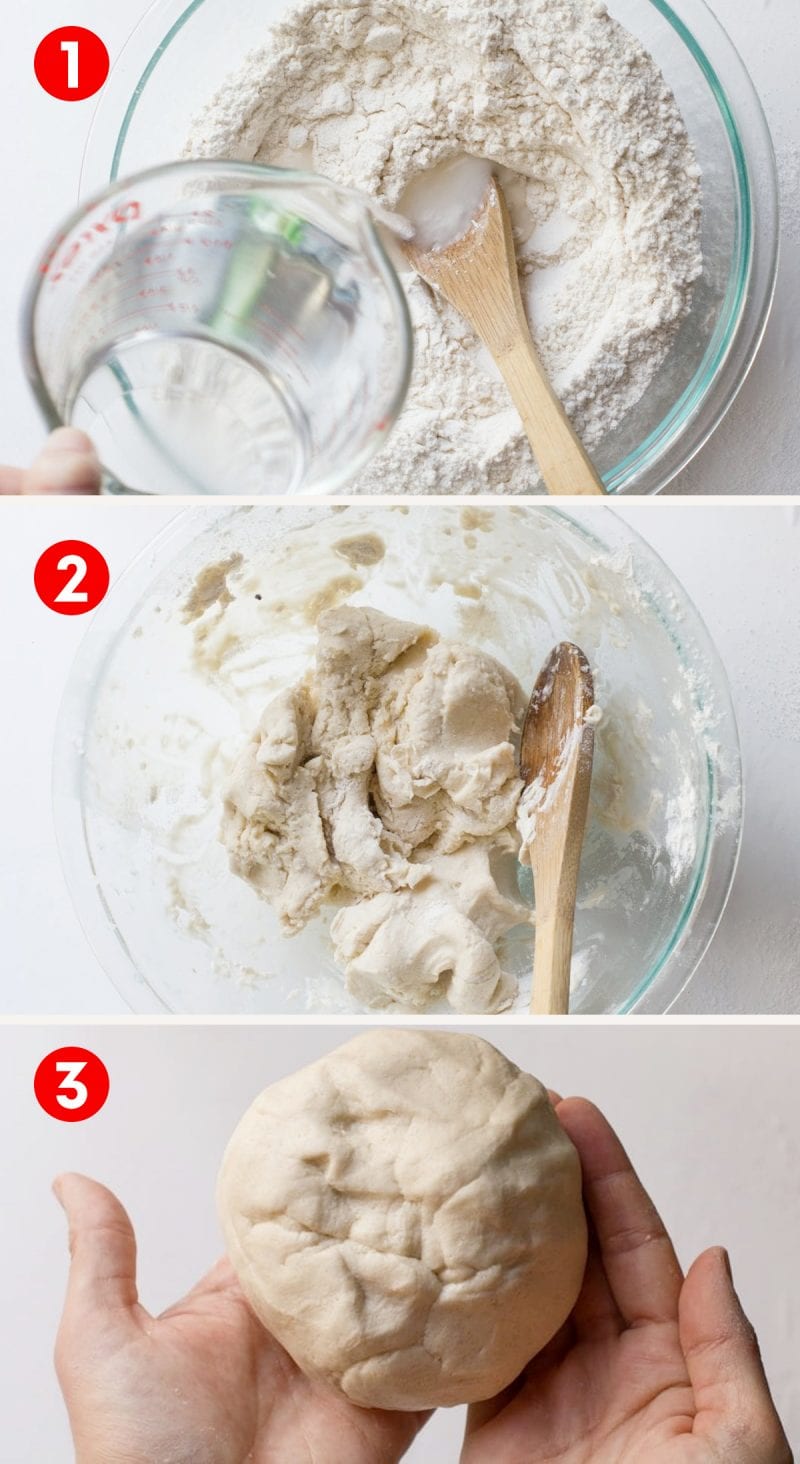
- Grab your large mixing bowl, and add in the flour and salt. Stir until well combined. Then, slowly stream in the warm water while stirring. Keep stirring until you've added all the water.
- You'll get to a point where it is too hard to stir with a spoon. Put it down and use your hands to get in there and mix it well.
- Once the dough starts to come together, keep kneading with your hands for a few minutes until the dough is smooth and pliable.
Form and shape your ornaments
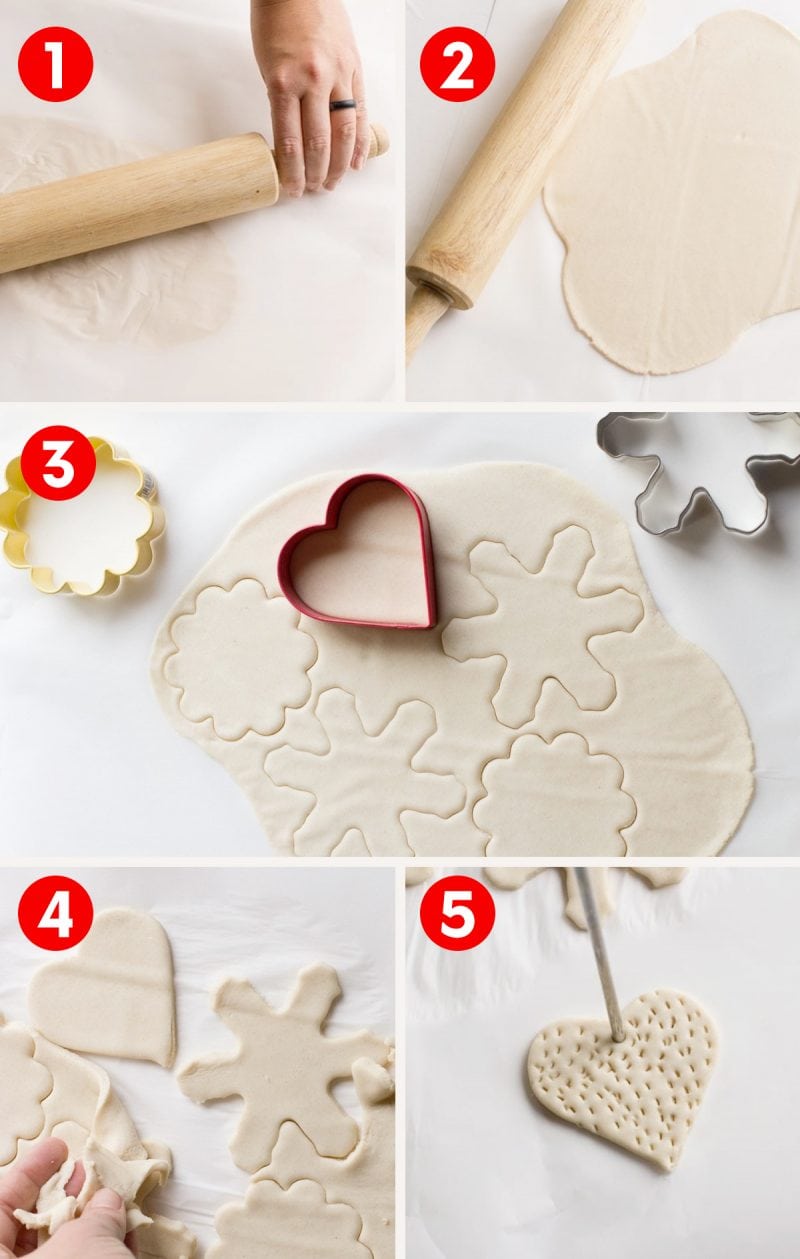
- Put down a large piece of parchment paper, and place a good-sized chunk of dough in the middle. Place another large piece of parchment on top.
- Roll out the dough until ⅛" thick. You want to err on the side of a thinner dough. Too thick, and the ornaments tend to split or break easily because of air pockets that get trapped in the middle.
- Remove the top sheet of parchment, and then and then use cookie cutters to cut into the dough cut into the dough-do not try to remove the cut out pieces! You want those to stay on the parchment.
- When you're finished cutting the pieces, peel away the excess dough, leaving behind the shapes on the parchment. This is a great time to add any texture to the dough if you want to-like by poking holes with a fork or dappling with a straw.
- Take a drinking straw, and poke a hole in the top of each ornament for a ribbon to hang from. Make sure to blow out the plug in the end of the drinking straw before you go to the next ornament. Trust me, I've ruined a good stainless steel straw or two by forgetting the dough inside and having it drying rock-solid inside!
Baking the ornaments

- Preheat oven to 200°F.
- Transfer the whole parchment paper and shapes onto a baking sheet. Bake the ornaments until hard. Start checking at about an hour, but it could take up to two. This isn't an exact science, because inevitably, your shapes won't be 100% even in thickness.
- They are done when they feel hard. They are really done if they start to brown (no worries, that's something we can fix later!).
- Let the ornaments cool completely before proceeding to the next step.
Decorating, preserving, and hanging
If you prefer the rustic, classic look of the salt dough, you can hang the ornaments as-is. But I think part of the fun of making salt dough ornaments is getting out the glitter and making a holiday mess.
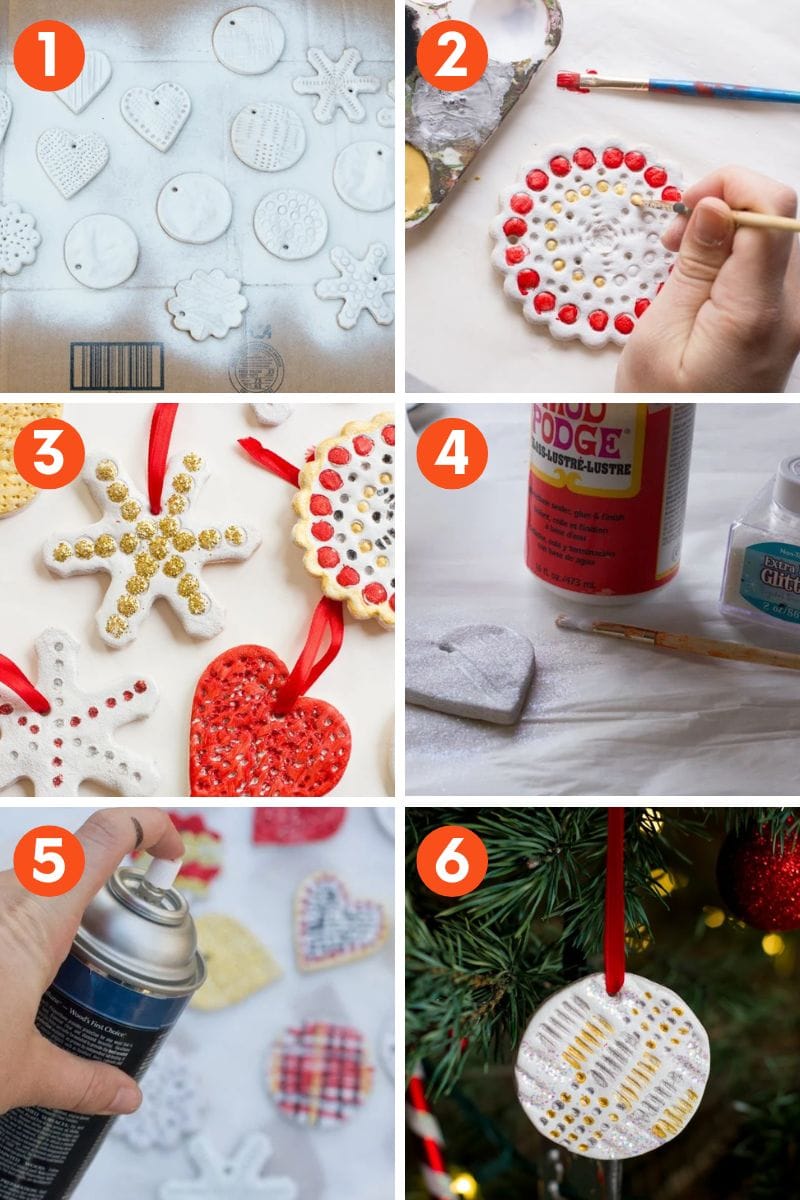
- Optional, but I like to mist all of my cooled ornaments with a thin coat of white spray paint. This helps cover up any irregularities in color (like when some got too brown from baking), and I think it helps the ornaments looks more like clay than hard bread.
- Once the spray paint is dry to the touch, I paint using acrylic paints and brushes (puffy paints would also work wonderfully).
- I like to use the textural spaces to help guide where I put paint-but it's really up to you to get creative on how you want to decorate.
- Where I want glitter, I use Mod Podge or school glue, then add glitter, shaking off the excess onto old newspaper.
- Sealing the ornaments will help keep all the decorations you just lovingly applied looking great for years to come. Once the decorations are dry, I like to use spray poly, but coating each one in a thin layer of Mod Podge would also do the trick.
- String up the ornaments using pretty ribbon or twine, and then put those beautiful new ornaments on your Christmas tree!
How to Make Salt Dough Handprints
Salt dough handprint ornaments (or pawprints!) are a great way to mark major milestones in your life! Here's how to do it:
- Roll out the dough as directed above, making it very slightly thicker than you would for regular ornaments.
- Evenly press the hand or foot in the dough.
- Cut around the handprint or footprint using the rim of a bowl or glass. You might be tempted to do the other way around (cut out the shape first, then get the handprint), but trust me on this one-wiggly, squirmy babies do not know how to center their hands into a shape! You're better off having a large piece of salt dough to "catch" the print, and then cutting out around it.
- Proceed with the baking, decorating, and sealing steps.

Variations and Substitutions
There are a few ways to make these ornaments your own, here's some of the variations on this method I've tried out over the years:
- Bake it faster: I've baked these at 300°F with good (and fast) results, but you do have to watch them like a hawk to prevent burning.
- Air-dry them: You could leave the ornaments out to air dry, but the drying process will probably take several days, depending on how thick the ornaments are and how humid it is. You'll also need to flip the salt dough ornaments several times to keep the edges from curling.
- Coloring the dough: Add in a few drops of food coloring to your dough before baking will result in a nicely colored dough, just know that the colors will slightly shift in the oven (just like they do when you are baking cookies or cupcakes)

Troubleshooting
Why did my salt dough puff up?
Salt dough projects tend to get puffy or bubble if the dough is too thick or if it isn't rolled out evenly. If the ornaments have air bubbles within them, that can also cause a puffiness.
My salt dough burned on the edges, but is still soft in the middle!
I know I sound like a broken record, but this is typically a result of the dough not being rolled out evenly. Or could be an oven with hot spots. For the next batch, try rotating your cookie sheet in the oven every 10-15 minutes. If you are still getting burnt spots, try covering the cookie sheet lightly with foil while the middle finishes cooking.
Salt Dough Tips and Tricks
Looking for more Christmas crafts and gifts?
- Cinnamon Ornaments. Looking for another easy holiday ornament craft? You can't beat our cinnamon ornaments. They smell great and are a blast to make with kids!
- Bird Seed Ornaments. These simple handmade ornaments will bring all the birds to your yard!
- Soup Mixes in a Jar. These affordable gifts in a jar are easy to pull together and make a thoughtful teacher's gifts, hostess gifts, or gifts for friends and family.
- M&M Cookie Mix in Jar. We gave these M&M Cookie Mixes as gifts a few years back, and everyone absolutely loved them! The cookies that are made from the mix are the BEST.
- How to Make Hot Sauce. Give the gift of some heat! We'll teach you just how easy it is to make your own homemade hot sauce.
Love this recipe? Leave a review!
If you love this recipe as much as I do, make sure to leave a 5-star review below to help others.
Want to save this recipe?
📖 Recipe

Salt Dough Recipe for Ornaments, Handprints, and Crafting
Equipment
- Glitter, paint, and ribbon for decoration
- Polyurethane spray for preservation
Ingredients
- 4 cups all-purpose flour
- 1 cup table salt
- 1 ½ cups warm water
Instructions
To Make Dough
- In a large bowl, whisk together the flour and salt. Slowly stream in the water while stirring until it comes together. Finish mixing together with hands. Knead until dough is soft, about five minutes.
To Bake Ornaments
- Preheat oven to 200°F. Place half of the dough between two large pieces of parchment paper. Roll out until ⅛" thick. Remove the top sheet of parchment.
- Using cookie cutters, cut shapes (leaving them on the parchment). Peel away the excess dough. Transfer the parchment with shapes to a baking sheet.
- Using a straw or toothpick, poke a hole for ribbon or an ornament hanger. Bake in the preheated oven until hard, starting to check at the hour mark. It could take as much as two hours.
- Once cooled, decorate using glitter and paint. To make sure the ornaments last a long time (I have one from 30 years ago!), spray with a light coat of polyurethane spray. Thread on a ribbon and hang on tree.
Video
Notes
- This recipe was originally posted with an oven temp of 300°F. While we've made many batches at this temperature successfully, some of you had poor results with this higher temperature. So, we adjusted the recipe to use a lower oven temperature for a longer bake time.




For two kids (6 and 4) recommend only making half of the recipe. Had plenty of dough to work with . We cooke ours at 200 degrees for 30 minutes and flipped cooked another 30. They came out perfect!
I made a half batch of this salt dough and didn’t modify the recipe at all. Rolled out the dough nice and even, and actually measured with my ruler that they were 1/8” thick. All 24 ornaments puffed up in the oven pretty quickly at 300 degrees. Really disappointed because we don’t want to try this all over again. If you’re going to use this recipe, I strongly suggest air drying or putting in the oven at a super low temp. I don’t know if we’re going to bother trying to decorate these puffy shapes. I think it’s going to be difficult, and I’m afraid these will be fragile. Wish I would’ve read the reviews first.
We're sorry it didn't turn out well for you, JC! We know some readers have had that issue, which is why we have a note at the top of the recipe card addressing it that says "PLEASE NOTE: A number of readers have had issues with their ornaments puffing and losing their shape. We haven't been able to replicate this in our own kitchens yet, but if you're concerned, we recommend lowering the oven temperature to 200°F and leaving them in for longer." We hope you give it a go at a lower temp and have better success. Please let us know how it goes if you make them again!
Can you use a sharpie on them or would that bleed?
Hi Gabby! If you're putting a base coat of white on the ornaments like we did here, then you should be able to use a sharpie without issue! Even on the uncoated ones, we haven't had an issue with sharpie bleeding, but you might want to make an extra one as a test ornament just to be sure it looks the way you want it to.
Can you make the salt dough ahead of time? How long will the dough keep?
Hi Cindy! We don't recommend this one for making ahead because the dough will start to dry out and harden. It's possible that if it's wrapped really, really well you might get a little extra time out of the dough (think making it in the morning and using it that afternoon). But it would depend on how well you could wrap it, and how long you left it. Generally speaking, we make this when we want to use it!
Can you use self rising flour? I have an excess of it that’s expired and looking for a use for it.
Hi Kelly! If you're planning to harden these in the oven, then self-rising flour wouldn't be a good option. They'll puff up lose their shape! Since you're trying to use up expired self-rising flour, though, you might want to experiment with air drying them. We haven't done it with self-rising flour, but you can leave the ornaments out to air dry instead of bake. They'll take much longer and need to be flipped a few times to make sure both sides dry, but it might be a way to use up your expired flour. I'd recommend testing it out before you make a huge batch. But if you have the patience (and space!) for the air-drying process, it could work.
How many ornaments can you get from this recipe?
Hi Abby! This recipe makes approximately 30 medium-sized ornaments.
What did you use to imprint your littles name on the handprint ornament?
Hi Erica! Cassie used letter rubber stamps to add names to the ornaments!